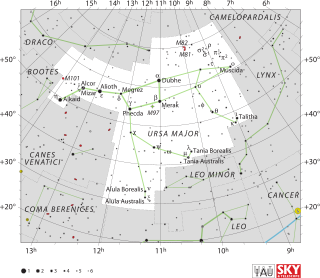4 Ursae Majoris
| Observation data Epoch J2000.0 Equinox J2000.0 |
|
|---|---|
| Constellation | Ursa Major |
| Right ascension | 08h 40m 12.81767s |
| Declination | +64° 19′ 40.5700″ |
| Apparent magnitude (V) | +4.620 |
| Characteristics | |
| Spectral type | K2 III |
| U−B color index | +1.193 |
| B−V color index | +1.159 |
| Astrometry | |
| Radial velocity (Rv) | +14.62 km/s |
| Proper motion (μ) |
RA: –60.05 mas/yr Dec.: +26.40 mas/yr |
| Parallax (π) | 12.74 ± 0.26mas |
| Distance | 256 ± 5 ly (78 ± 2 pc) |
| Absolute magnitude (MV) | 0.150 |
| Details | |
| Mass | 1.234 ± 0.15 M☉ |
| Radius | 18.79±0.38 R☉ |
| Luminosity | 112.4±10.0 L☉ |
| Surface gravity (log g) | 1.8 ± 0.15 cgs |
| Temperature | 4336±99 K |
| Metallicity [Fe/H] | -0.25 ± 0.04 dex |
| Rotational velocity (v sin i) | 8 km/s |
| Age | 4.18 ± 1.95 Gyr |
| Other designations | |
| Database references | |
| SIMBAD | data |
4 Ursae Majoris (sometimes abbreviated 4 Uma) is the Flamsteed designation of a star in the northern circumpolar constellation of Ursa Major. It also bears the Bayer designation of Pi² Ursae Majoris (Pi² UMa, π² Ursae Majoris, π² UMa) and is traditionally named Muscida. With an apparent visual magnitude of +4.6, this star is visible from suburban or darker skies based upon the Bortle Dark-Sky Scale. From parallax measurements made during the Hipparcos mission, this star is at a distance of 256 light-years (78 parsecs) from Earth. As of 2011[update], one extrasolar planet has been confirmed to be orbiting the star.
This star has a stellar classification of K2 III, indicating that, at an estimated age of around four billion years, it is an evolved star that has reached the giant stage. It has a mass about 1.2 times larger than the Sun, but has expanded to 18 times the Sun's girth. The effective temperature of the star's outer atmosphere is 4,415 K. This heat gives it the cool, orange-hued glow of a K-type star.
Pi² Ursae Majoris is a member of the Milky Way galaxy's thin disk population. It is following an orbit through the galaxy with an eccentricity of 0.10, which carries it as close to the Galactic Center as 27.7 kly (8.5 kpc) and as far as 34.1 kly (10.5 kpc). The inclination of this orbit lies close to the galactic plane, so it departs this plane by no more than 260 light-years (80 parsecs).
...
Wikipedia

